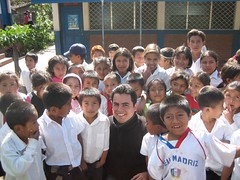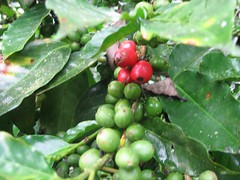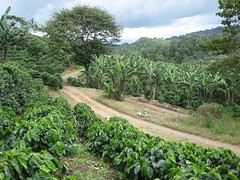Every week I'll be posting the latest papers on Agricultural Economy published by universities, journals, and Ag Econ meetings. These are extremely technical, with lots of econometrics that may seem too abstract to non-economist. Yet they can be useful to some of the readers out there with a trained eye on these subjects.
There are about 25 papers; read over the titles and click the ones that you find interesting. Check out the one on Returns on Education, using the case of Nigeria. The paper provides a very informative literature review about the different work done on this subject.
Remember to click the READ MORE link to see the full post. And also, click on the labels to see related posts.
Food Sector Transformation and Standards in Zambia: Smallholder FarmerParticipation and Growth in the Dairy SectorDepartment of Agricultural Economics Staff Paper 2006-18Michigan State University2006David NEVEN; Hikuepi KATJIUONGUA; Ingrid ADJOSOEDIRO; Thomas REARDON;Pia CHUZU; Gelson TEMBO; Mukelabai NDIYOI********************************************
probabilities introduce spurious correlationSelected PaperAmerican Agricultural Economics Association - 20062006 Annual Meeting, July 23-26, 2006, Long Beach, California2006Travis J. LYBBERT; David R. JUST
Potential Effects of Transgenic Rice on Farm Households\' NutritionalStatus in BangladeshSelected Paper 156562American Agricultural Economics Association - 20062006 Annual Meeting, July 23-26, 2006, Long Beach, California2006Yan Liang; Dixie W. Reaves; George W. Norton
********************************************
The Impact of Global Cotton Markets on Rural Poverty in PakistanSelected PaperAmerican Agricultural Economics Association - 20062006 Annual Meeting, July 23-26, 2006, Long Beach, California2006David ORDEN; Abdul SALAM; Reno DEWINA; Hina NAZLI; Nick MINOT
********************************************
Can Cocoa Farmer Organizations Countervail Buyer Market Power?Selected PaperAmerican Agricultural Economics Association - 20062006 Annual Meeting, July 23-26, 2006, Long Beach, California2006Michael WILCOX; Philip ABBOTT
********************************************
Potential Effects of Transgenic Rice on Farm Households' NutritionalStatus in BangladeshSelected Paper 156562American Agricultural Economics Association - 20062006 Annual Meeting, July 23-26, 2006, Long Beach, California2006Yan Liang; Dixie W. Reaves; George W. Norton
********************************************
The Impact of Global Cotton Markets on Rural Poverty in PakistanSelected PaperAmerican Agricultural Economics Association - 20062006 Annual Meeting, July 23-26, 2006, Long Beach, California2006David ORDEN; Abdul SALAM; Reno DEWINA; Hina NAZLI; Nick MINOT
********************************************
Can Cocoa Farmer Organizations Countervail Buyer Market Power?Selected PaperAmerican Agricultural Economics Association - 20062006 Annual Meeting, July 23-26, 2006, Long Beach, California2006Michael WILCOX; Philip ABBOTT
********************************************
http://agecon.lib.umn.edu/cgiU.S. and Canadian Livestock Prices: Market Integration and Trade DependenceSelected Paper 156074American Agricultural Economics Association - 20062006 Annual Meeting, July 23-26, 2006, Long Beach, California2006Dragan Miljkovic
********************************************
Is Individual Behavior Oriented to Self-interest, Other-interest orboth? Empirical Evidence from a Case Study of Social CapitalSelected PaperAmerican Agricultural Economics Association - 20062006 Annual Meeting, July 23-26, 2006, Long Beach, California2006Zhenyu ZHANG; Gary D. LYNNE
********************************************
Cattle Producers? Participation in Market Channels in Central America:Supermarkets, Processors, and AuctionsDepartment of Agricultural Economics Staff Paper 2006-01Michigan State University2006Fernando BALSEVICH; Paul SCHUETZ; Edwin PEREZ
********************************************
Farmer Willingness to Grow Switchgrass for Energy ProductionSelected PaperAmerican Agricultural Economics Association - 20062006 Annual Meeting, July 23-26, 2006, Long Beach, California2006Kimberly Jensen; Christopher D. Clark; Pamela Ellis; Burton English;Jamey Menard; Marie Walsh",1]
Miljkovic
********************************************
s Individual Behavior Oriented to Self-interest, Other-interest orboth? Empirical Evidence from a Case Study of Social CapitalSelected PaperAmerican Agricultural Economics Association - 20062006 Annual Meeting, July 23-26, 2006, Long Beach, California2006Zhenyu ZHANG; Gary D. LYNNE
********************************************
Cattle Producers? Participation in Market Channels in Central America:Supermarkets, Processors, and AuctionsDepartment of Agricultural Economics Staff Paper 2006-01Michigan State University2006Fernando BALSEVICH; Paul SCHUETZ; Edwin PEREZ
********************************************
Farmer Willingness to Grow Switchgrass for Energy ProductionSelected PaperAmerican Agricultural Economics Association - 20062006 Annual Meeting, July 23-26, 2006, Long Beach, California2006Kimberly Jensen; Christopher D. Clark; Pamela Ellis; Burton English;Jamey Menard; Marie Walsh
********************************************
Analysis of Farm Service Agency Direct Loan Loss Likelihoods and Loss RatesSelected PaperAmerican Agricultural Economics Association - 20062006 Annual Meeting, July 23-26, 2006, Long Beach, California2006Bruce L. Ahrendsen; Bruce L. Dixon; O. John Nwoha; Sandra J. Hamm; DianaDanforth
********************************************
Biological Invasions: The Case of Soybean Aphid InfestationSelected PaperAmerican Agricultural Economics Association - 20062006 Annual Meeting, July 23-26, 2006, Long Beach, California2006C. S. Kim; G. Schaible; L. Garrett; R. Lubowski; D. Lee********************************************
Effects of Herbicide-Resistant Technology Fees on the Plant PopulationDecision for Cotton ProductionSelected PaperAmerican Agricultural Economics Association - 20062006 Annual Meeting, July 23-26, 2006, Long Beach, California2006James LARSON; Roland ROBERTS; Owen GWATHMEY
********************************************
********************************************
********************************************
********************************************
Factors Affecting Direct and Indirect Energy Use in U.S. Corn ProductionSelected PaperAmerican Agricultural Economics Association - 20062006 Annual Meeting, July 23-26, 2006, Long Beach, California2006Wesley Musser; Dayton Lambert; Stan Daberkow
********************************************
Analysis of Farm Service Agency Direct Loan Loss Likelihoods and Loss RatesSelected PaperAmerican Agricultural Economics Association - 20062006 Annual Meeting, July 23-26, 2006, Long Beach, California2006Bruce L. Ahrendsen; Bruce L. Dixon; O. John Nwoha; Sandra J. Hamm; DianaDanforth
********************************************
Biological Invasions: The Case of Soybean Aphid InfestationSelected PaperAmerican Agricultural Economics Association - 20062006 Annual Meeting, July 23-26, 2006, Long Beach, California2006C. S. Kim; G. Schaible; L. Garrett; R. Lubowski; D. Lee
********************************************
Effects of Herbicide-Resistant Technology Fees on the Plant PopulationDecision for Cotton ProductionSelected PaperAmerican Agricultural Economics Association - 20062006 Annual Meeting, July 23-26, 2006, Long Beach, California2006James LARSON; Roland ROBERTS; Owen GWATHMEY
********************************************
Africa's Education Enigma? The Nigerian story.
American Agricultural Economics Association - 20062006 Annual Meeting, July 23-26, 2006, Long Beach, California2006Ruth Uwaifo
********************************************
Modeling Conservation Program Impacts: Accounting for participationusing bootstrappingSelected PaperAmerican Agricultural Economics Association - 20062006 Annual Meeting, July 23-26, 2006, Long Beach, California2006Daniel Hellerstein
********************************************
On the spatial nature of the groundwater pumping externalitySelected PaperAmerican Agricultural Economics Association - 20062006 Annual Meeting, July 23-26, 2006, Long Beach, California2006Nicholas BROZOVIC; David SUNDING; David ZILBERMAN
********************************************
Factors Affecting Direct and Indirect Energy Use in U.S. Corn ProductionSelected PaperAmerican Agricultural Economics Association - 20062006 Annual Meeting, July 23-26, 2006, Long Beach, California2006Wesley Musser; Dayton Lambert; Stan Daberkow
********************************************
Modeling Conservation Program Impacts: Accounting for participationusing bootstrappingSelected PaperAmerican Agricultural Economics Association - 20062006 Annual Meeting, July 23-26, 2006, Long Beach, California2006Daniel Hellerstein
********************************************
On the spatial nature of the groundwater pumping externalitySelected PaperAmerican Agricultural Economics Association - 20062006 Annual Meeting, July 23-26, 2006, Long Beach, California2006Nicholas BROZOVIC; David SUNDING; David ZILBERMAN
********************************************
Factors Affecting Direct and Indirect Energy Use in U.S. Corn ProductionSelected PaperAmerican Agricultural Economics Association - 20062006 Annual Meeting, July 23-26, 2006, Long Beach, California2006Wesley Musser; Dayton Lambert; Stan Daberkow********************************************







